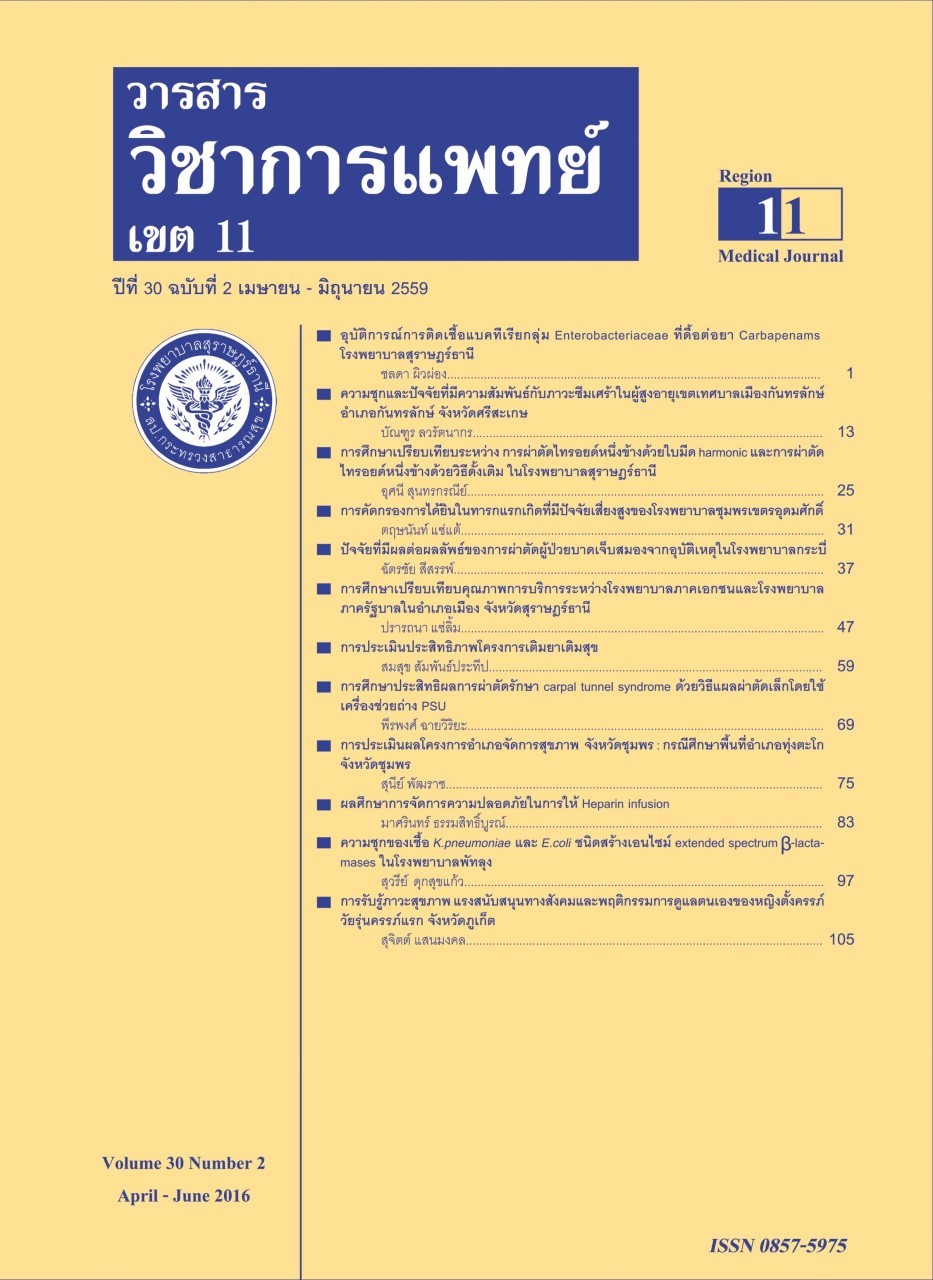Incidence of Carbapenem–resistant Enterobacteriaceae in Suratthani Hospital
Keywords:
Carbapenem–resistant Enterobacteriaceae (CRE), Suratthani hospitalAbstract
Carbapenem–resistant Enterobacteriaceae (CRE) infection in the hospital is a major problem that has a direct impact to patients,health personnel and hospital. The purpose of this retrospective,
descriptive research was to study the incidence rate of CRE and to investigate factors associated with CRE in the hospital. The subjects were patients who were admitted in Suratthani hospital. The data were collected from October, 1 2013 to September, 30 2015. The CRE infection in the hospital data collection form and criterion of infection in Suratthani hospital that was adopted from the Centers for Disease Control and Prevention (CDC), USA (1992 ; 2002) was used to collect the data.The data were analyzed using descriptive statistics, Chi-square test Fisher’s exact test and Mann-Whitney U test.Carbapenem–resistant Enterobacteriaceae (CRE) infection in the hospital is a major problem that has a direct impact to patients,health personnel and hospital. The purpose of this retrospective,
descriptive research was to study the incidence rate of CRE and to investigate factors associated with CRE in the hospital. The subjects were patients who were admitted in Suratthani hospital. The data were collected from October, 1 2013 to September, 30 2015. The CRE infection in the hospital data collection form and criterion of infection in Suratthani hospital that was adopted from the Centers for Disease Control and Prevention (CDC), USA (1992 ; 2002) was used to collect the data.The data were analyzed using descriptive statistics, Chi-square test Fisher’s exact test and Mann-Whitney U testThe results revealed that in 2015 the total of patient days was 281,622 days or 60,961 discharged patients. CRE infection was diagnosed 35 times. The nosocomial infection rate was 0.12 times/1000 patient days and 0.57 times/1000 discharged patient. The majority of the patients’ infections were caused by ventilator-associated pneumonia (34.80%); followed by catheter-related urinary tract infection (30.40%). The most common pathogens were Klebsiella pneumonia (60.70%), Escherichia coli (26.80%) and Enterobacter cloacae (8.93%).The number of patients between 16-59 years and over 60 years were
almost similar (41.80% and 52.70% respectively). Most of the patients did not received antibiotics in the past 3 months. However, most of them have a history of immunocompromised host (92.70%) and received catheter insertion (80.00%). Majority of the patients were admitted in medical ward (46.30%), followed by surgical ward (42.00%). Patients with CRE infection had a higher cost of antibiotic and a longer length of stay than those who were not infected (111,864.00 and 115,23.25 baht; 67.00 and 26.70 days, respectively). Moreover, the length of stay in thehospital of the study group was significantly higher than those in the control group (p <0.05).The results of this study suggested that controlling and preventing CRE infection in medical ward and surgical ward were important and necessary. Especially among patients who were admitted in the hospital for longer than 4 weeks.
References
2. Horan, T.C., Andrus, M. & Dudeck, M.A CDC/NHSN surveillance definition of healthcare-associated infection and criteria for specific types of infection in the acute care setting. Am J Infect Control 2008;36 : 309-32.
3. http://www.cdc.gov/hai/organisms/cre/definition.html#
4. Guh AY, Bulens SN, Mu Y, Jacob JT, Reno J, Scott J,et al. Epidemiology of Carbapenem-Resistant
Enterobacteriaceae in 7 US Communities, 2012-2013. JAMA 2015; Oct 13; 314(14):1479-87
5. อุราภรณ์ ภูมิศานติพงศ์. อุบัติการณ์ของเชื้อ Enterobacteriaceae ที่ดื้อยากลุ่ม carbapenems. Vajira Medical Journal, 2011; 55 : 3 : 265-272.
6. ศูนย์เฝ้าระวังเชื้อดื้ยาต้านจุลชีพแห่งชาติ กระทรวงสาธารณสุข. สถานการณ์เชื้อดื้อยาใน ประเทศไทย.http://narst.dmsc.moph.go.th/news001.html.
7. อะเคื้อ อุณหเลขกะ. หลักและแนวปฏิบัติการป้องกันการติดเชื้อในโรงพยาบาล. เชียงใหม่ :บริษัท มิ่งเมืองนวรัตน์ จำกัด; 2545.
8. อะเคื้อ อุณหเลขกะ. ระบาดวิทยาและแนวปฏิบัติในการป้องกันการติดเชื้อในโรงพยาบาล. เชียงใหม่ : บริษัทมิ่งเมืองนวรัตน์ จำกัด; 2556.
9. ภาณุมาศ ภูมาศ; วิษณุ ธรรมลิขิตกุล; ภูษิต ประคองสาย; ตวงรัตน์ โพธะ; อาทร ริ้วไพบูลย์; สุพล ลิมวัฒนานนท์. ผลกระทบด้านสุขภาพและเศรษฐศาสตร์จากการติดเชื้อดื้อยาต้านจุลชีพในประเทศไทย : การศึกษาเบื้องต้น. สถาบันวิจัยระบบสาธารณสุข, 2555; 6: (3):338-351.
10. รายงานพิเศษ. เชื้อดื้อยาปฏิชีวนะวิกฤตและทางออกของสังคมไทย.จุลสาร HSRI Forum ปีที่ 1 ฉบับที่ 1 มิถุนายน 2555. http://old.hsri.or.th/sites/default/files/hsri-forum-website.pdf .
11. Neil Gupta , Brandi M. Limbago, Jean B. Patel,and Alexander J. Kallen. Carbapenem-Resistant
Enterobacteriaceae: Epidemiology and Prevention.Clinical Infectious disease 2011; 53, 60-67.
12. รายงานผลการตรวจทางห้องปฏิบัติการโรงพยาบาลสุราษฎร์ธานี. (2559).เอกสารอัดสำเนา
13. Yanling Xu, Bing Gu, Mao Huang, Haiyan Liu, Ting Xu, Wenying Xia, and Tong Wang. Epidemiology
of carbapenem resistance Enterobacteriaceae (CRE)during 2000-2012 in Asia. J Thorac Dis. 2015
Mar; 7(3):376-385.
14. พุทธชาด ขันตี และ กุลกัญญา โชคไพบูลย์กิจ.Update of Carbapenem – Resistant Enterobacteriociae.
หน่วยโรคติดเชื้อ ภาควิชากุมารเวชศาสตร์ คณะแพทยศาสตร์ศิริราชพยาบาล.สมาคมโรคติดเชื้อในเด็กแห่งประเทศไทย; 2559. http://www.pidst.net/A464.html.
15. http://www.cdc.gov/hai/organisms/cre/cre-clinicianFAQ.html
16. Zilberberg MD, Shorr AF.Secular trends in gramnegative resistance among Urinary tract infection hospitalizations in the United State, 2000-2009.Infect Control Hosp Epidemiol 2013, 940-6.
17. วิษณุ ธรรมลิขิตกุล. คู่มือการควบคุมและป้องกันแบคทีเรียดื้อยาต้านจุลชีพในโรงพยาบาล.โครงการควบคุมและป้องกันการดื้อยาต้านจุลชีพในประเทศไทย; 2558.
18. Michael Y. Lin , Rosie D. Lyles-Banks, Karen Lolans, David W. Hines,Joel B. Spear et al. The Importance of Long-term Acute Care Hospitals in the Regional Epidemiology of Klebsiella pneumonia Carbapenemase-Producing Enterobacteriaceae. CID 2013:57 (1 November)
19. Parker VA, Logan CK, Currie B. Carbapenem-resistant Enterobacteriaceae(CRE) Control and Prevention Toolkit. AHRQ 2014 Publication N0.14-0028-EF.





